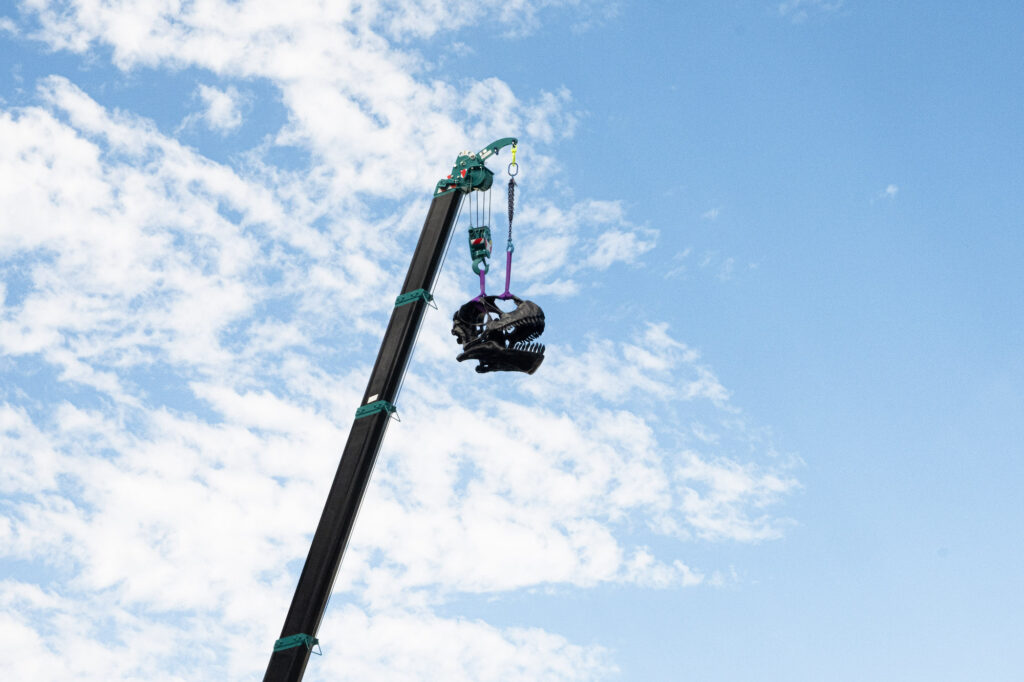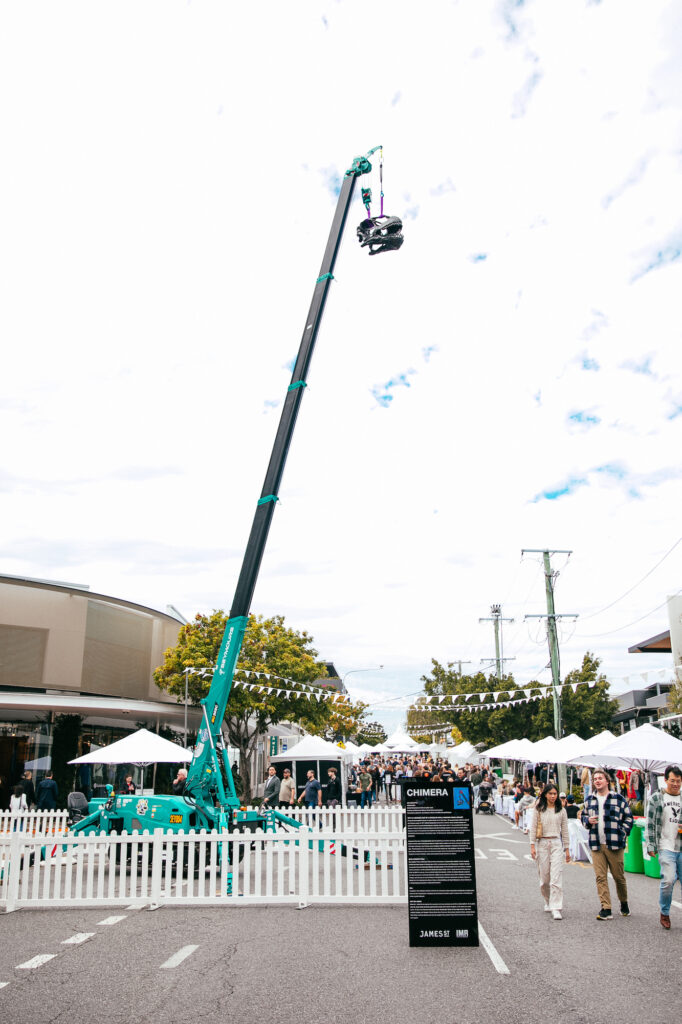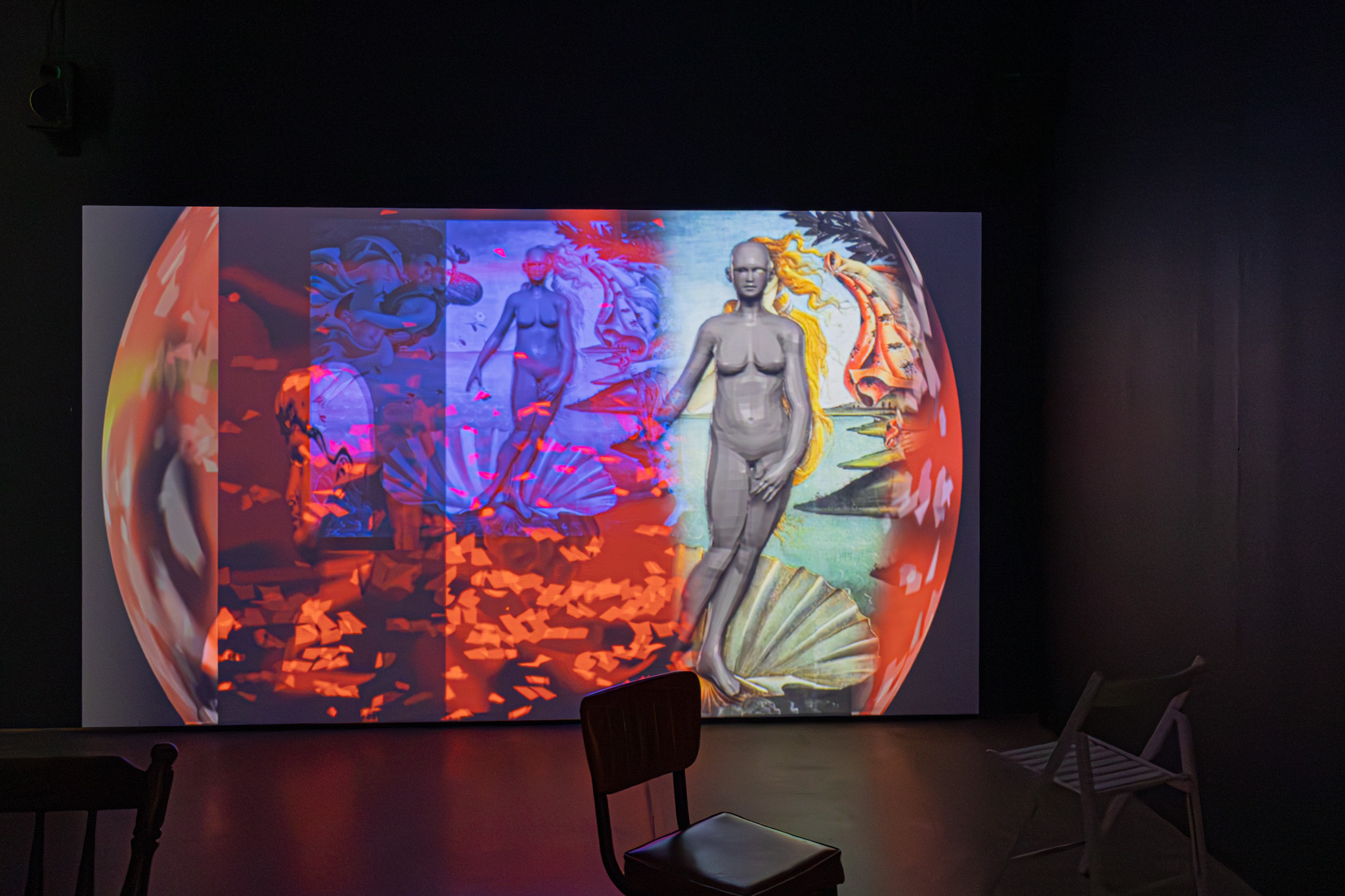
Chimera—a large-scale installation of cast bronze mounted to a 2.8 tonne portable crane—inspired a provocative sentiment at this year’s James Street Food and Wine Trail. The sauropod skull, suspended 12.5 metres above the skyline and evoking a sense of biological grandeur and the greater scale of time, was met with amusement and intrigue . Standing in for the postcranial elements of the dinosaur were a boom, undercarriage, and outriggers. These simulated the quadrapedial body structure of an enormous terrestrial vertebrate.
The IMA describes Chimera as “a new hybrid monument.” The stature of the crane yields both anatomical correctness and scale, while also signifying the artistic spirit and conceptual practice of artist Zac Langdon Pole. This polymorphic assemblage deftly crosses the threshold between gallery work and public art. For Langdon-Pole, these are the same; they both operate under the same tacit agreement between audience and artist.
“Langdon-Pole is an artist, not a historian or scientist. His works refer to history and science, but don’t contribute to them; they contribute to art.”—Robert Leonard

For Langdon Pole, Chimera’s hybridising of a 1:1 scale bronze-cast fossil with a Maeda 305 spider crane challenges taxonomic classification and points to “the hubris and fragility in the naming of things and beings.” To understand this point, the IMA explains:
In the late-nineteenth century, US palaeontologists rushed to discover new dinosaur species. In 1877, Othniel Charles Marsh discovered a massive, almost complete skeleton of a species that he went on to name the Brontosaurus, meaning ‘noble thunder lizard’. It was assembled at the American Museum of Natural History, becoming famous as the first full dinosaur skeleton to be placed on public display. But it wasn’t a full specimen, but a hybrid of two long-necked dinosaurs: its body was from an Apatosaurus, its head from a Camarasaurus. Nevertheless, today, ‘the Brontosaurus’ remains a fixture in the popular imagination.
The taxonomic systems of classification used to define species and apply logical structure to all of the natural world are, at the best of times, a work in progress. Phylogenetic trees, depicting relationships between genera and species, are constantly challenged and revised. Equally, during the Enlightenment’s archaeological rush toward scientific discovery, dinosaurs were mythically constructed and deconstructed. As Adorno and Horkheimer explain, myths: “sought to report, to name, to tell of origins—but therefore also to narrate, record, explain.” In other words, they argue, scientific myths such as the Brontosaur themselves fell victim to the rationalised order of the Enlightenment. And just as new myths of empirical science afforded us scientific advances, they simultaneously reconstructed our sense of the world.
“Natural History is a cousin of the art world”—Zac Langdon Pole.
In the rush to collect fossilised bones across America, excavations were led by Othniel Charles Marsh and Edward Drinker Cope, duelling palaeontologists of the Gilded Age. To exchange early blows, the two weaponised the medium of scientific publication and by the end of the Post-bellum period these titans had defined 136 new species of dinosaur.
Due to the sagittarian tendencies of palaeontologists, chimaeras occur as false or temporary pieces within the greater puzzle of natural history. In exhibitions and popular articles, chimaeras in the fossil record are often framed as the result of human error or haste. However, within the hierarchy of empirical science, the designation of one specimen as the holotype of a species—that is, the use of a single example of an organism to formally describe a whole species—is the standard way forward. In turn, chimaeras occur naturally as part of the naming process when dealing with incomplete materials and fragmentary deposits. Langdon Pole’s work translates the essence of this “story of miscategorisation and the disordering of scientific knowledge” into Chimera.

Chimera alludes to the entanglement of fossil and fable. Moreover, the crane as placeholder for mythical beasts of folk and fable also iterates the death of God. Chimera provokes new paradoxes regarding the fallibility of belief, contrasting the Enlightenment’s knowledge as myth with the post-Enlightenment humility of discovered errors and the grandeur of art’s possibilities. In this contemporary moment and the localised context of our pre-Olympic city, Chimera also points to how this decade will eventually compact into a fraction of a single layer in the fossil record, requiring less than a single sheet of paper in a rather heavy book. Against this future reality, and despite its one-day temporary installation, Chimera will resound in the memory of those who experienced it.
@unregisteredmasterbuilder Joseph’s creative practice rests at the axis between textiles, motion and sound. Joseph has contributed to projects across Europe, North-America, the Middle-East and Australia; most recently deploying projects with Atelier Sisu (AU) and Barcelona-based Onion Labs (ES) as an animator and sound artist. Currently residing in Meanjin, Joseph is a director of KEPK and has focused on curating long-form durational sound projects and experimental showcases. Joseph is currently undertaking a Masters by Research exploring the interface between Romantic-era technology and the absence of sound in modern-carpet making.



